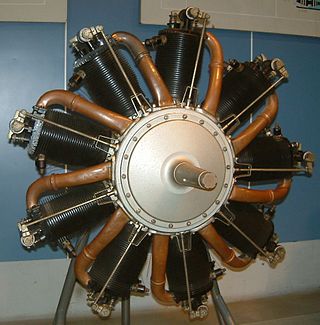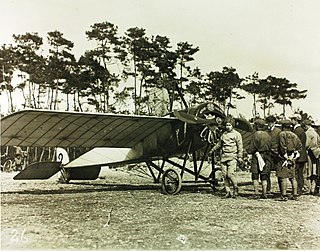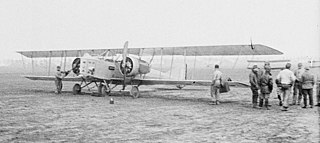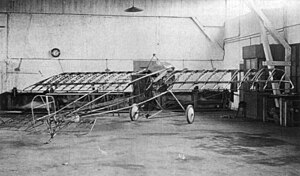
The Fokker Scourge occurred during the First World War from July 1915 to early 1916. Imperial German Flying Corps units, equipped with Fokker Eindecker fighters, gained an advantage over the Royal Flying Corps (RFC) and the French Aéronautique Militaire.

This is a list of aviation-related events from 1915:

The Morane-Saulnier N, also known as the Morane-Saulnier Type N, was a French monoplane fighter aircraft of the First World War. Designed and manufactured by Morane-Saulnier, the Type N entered service in April 1915 with the Aéronautique Militaire designated as the MoS-5 C1. It also equipped four squadrons of the Royal Flying Corps, in which it was nicknamed the Bullet, and was operated in limited numbers by the 19th Squadron of the Imperial Russian Air Force.

The Fokker Eindecker fighters were a series of German World War I monoplane single-seat fighter aircraft designed by Dutch engineer Anthony Fokker. Developed in April 1915, the first Eindecker ("Monoplane") was the first purpose-built German fighter aircraft and the first aircraft to be fitted with a synchronization gear, enabling the pilot to fire a machine gun through the arc of the propeller without striking the blades. The Eindecker gave the German Army's Air Service (then the Fliegertruppen des deutschen Kaiserreiches) a degree of air superiority from July 1915 until early 1916. This period, during which Allied aviators regarded their poorly armed aircraft as "Fokker Fodder", became known as the "Fokker Scourge".

The Fokker E.I was the first fighter aircraft to enter service with the Fliegertruppe of the Deutsches Heer in World War I. Its arrival at the front in mid-1915 marked the start of a period known as the "Fokker Scourge" during which the E.I and its successors achieved a measure of air superiority over the Western Front.

The Fokker E.II was the second variant of the German Fokker Eindecker single-seat monoplane fighter aircraft of World War I. The E.II was essentially a Fokker E.I with the 75 kW (100 hp) Oberursel U.I 9-cylinder rotary engine, a close copy of the French Gnôme Monosoupape rotary of the same power output, in place of the E.I's 60 kW (80 hp) Oberursel U.0, but whereas the E.I was simply a M.5K with a 7.92 mm (.312 in) machine gun bolted to it, the E.II was designed with the weapon system integrated with its airframe.

The Fokker E.III was the main variant of the Eindecker fighter aircraft of World War I. It entered service on the Western Front in December 1915 and was also supplied to Austria-Hungary and Turkey.

The Morane-Saulnier L, or Morane-Saulnier Type L, or officially MoS-3, was a French parasol wing one or two-seat scout aeroplane of the First World War. The Type L became one of the first successful fighter aircraft when it was fitted with a single machine gun that fired through the arc of the propeller, which was protected by armoured deflector wedges. Its immediate effectiveness in this role launched an arms race in fighter development, and the Type L was swiftly rendered obsolete. The original Type L used wing warping for lateral control, but a later version designated Type LA was fitted with ailerons.

The Deutsche Luftstreitkräfte – known before October 1916 as Die Fliegertruppen des deutschen Kaiserreiches – was the air arm of the Imperial German Army. In English-language sources it is usually referred to as the Imperial German Air Service, although that is not a literal translation of either name. German naval aviators of the Marine-Fliegerabteilung were an integral part of the Imperial German Navy. Both military branches operated aeroplanes, observation balloons and airships.

The Morane-Saulnier Type P was a French parasol wing two-seat reconnaissance aeroplane of the First World War. Morane-Saulnier built 595 for the French air force, and it was also used by the British until 1916-17.

Le Rhône was the name given to a series of rotary aircraft engines built between 1910 and 1920. Le Rhône series engines were originally sold by the Société des Moteurs Le Rhône and, following a 1914 corporate buyout, by its successor company, Gnome et Rhône. During World War I, more than 22,000 nine cylinder Le Rhône engines were built, with the type far outselling Gnome et Rhône's other main wartime engine series, the Gnome Monosoupape.

The Parabellum MG 14 was a 7.92 mm caliber World War I machine gun built by Deutsche Waffen und Munitionsfabriken. It was a redesign of the Maschinengewehr 08 machine gun system intended for use on aircraft and zeppelins. Like the earlier Vickers machine gun, it used a toggle action that broke upwards rather than downwards, the opposite way to the MG 08, making for a much more compact receiver. The fusee spring was replaced with an internal spring design, the breech block was completely different and the spent cartridges dropped out the bottom of the receiver, rather than being ejected forward through a hole under the breech from the receiver. There appear to be no action or receiver parts interchangeable with the MG 08. The MG 08's belt-style ammunition feed was enclosed in a drum, the recoil casing was lightened and the cooling jacket was modified for air- instead of water-cooling. The rate of fire was 700 rounds/minute. The belt was reduced to 30 mm in width.

The Fokker M.7 was a German observation aircraft of World War I, used by the armed forces of both Germany and Austro-Hungary.

The Fokker A.I was an "A-class" unarmed two-seat monoplane observation aircraft of the 1914-15 era early in World War I, powered as the earlier Fokker M.5 was, by a 58.8 kW (80 PS) Oberursel U.0 seven cylinder rotary engine, or umlaufmotor, a near-clone of the Gnome Lambda rotary engine of the same power output level — the same U.0 seven cylinder rotary engine version was used on all Fokker military monoplanes before the Fokker E.II Eindecker fighter's debut in 1915-16. The A.I aircraft resembled a substantially enlarged Fokker M.5, with a tall dorsal cabane structure to handle the triple sets of stationary flying and landing wires anchored to the wing panels' forward spar, each panel having fourteen wing ribs, and the similarly triple sets of wing warping cables attached to the rear spar. The A.I and earlier A.IIs were both built by Fokker and license-built by Halberstadt. The origins of the A.I, A.II and A.III were in a Morane-Saulnier Type H purchased from France. This led to the initial Fokker M.5 airframe designed by Martin Kreutzer, from which the larger A.I was derived. Fokker gave many aerobatic demonstrations in the M.5 on the eve of World War I. The M.8, was ordered as the A.I by the Fliegertruppe and between Fokker and Halberstadt, about 63 were produced.

The Morane-Saulnier G was a two-seat sport and racing monoplane produced in France before the First World War. It was a development of the racing monoplanes designed by Léon Morane and Raymond Saulnier after leaving Borel and, like its predecessors, was a wire-braced, shoulder-wing monoplane. Construction was of fabric-covered wood throughout, except for the undercarriage struts which were of steel tube.

The Morane-Saulnier AI was a French parasol-wing fighter aircraft produced by Morane-Saulnier during World War I.

LeutnantKurt Wintgens was a German World War I fighter ace. He was the first fighter pilot to score an aerial victory with a synchronized machine gun. Wintgens was the recipient of the Iron Cross and the Pour le Mérite.

The Morane-Saulnier H was an early aircraft first flown in France in the months immediately preceding the First World War; it was a single-seat derivative of the successful Morane-Saulnier G with a slightly reduced wingspan Like the Type G, it was a successful sporting and racing aircraft: examples serving with the French army were used in the opening phases of the war.

The Morane-Saulnier T was a French biplane reconnaissance aircraft in 1916 and produced in small numbers during World War I.



















